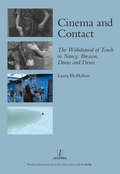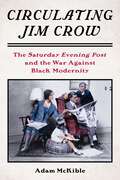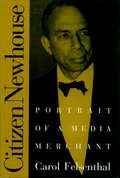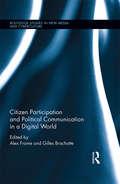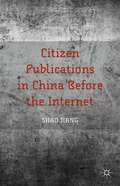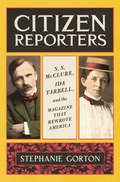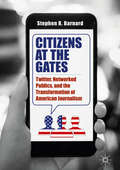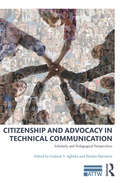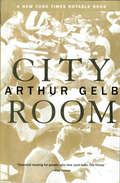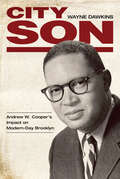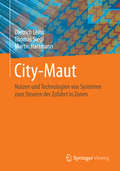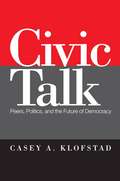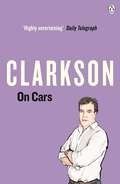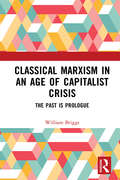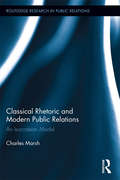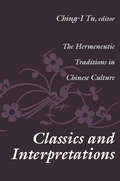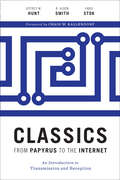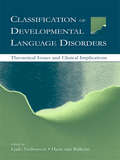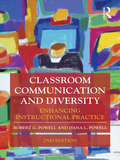- Table View
- List View
Cinema and Contact: The Withdrawal of Touch in Nancy, Bresson, Duras and Denis
by Laura McMahonDrawing on the work of contemporary French philosopher Jean-Luc Nancy, Cinema and Contact investigates the aesthe-tics and politics of touch in the cinema of three of the most prominent and distinctive filmmakers to have emerged in France during the last fifty years: Robert Bresson, Marguerite Duras and Claire Denis. Countering the domi-nant critical account of touch elaborated by recent models of embodied spectatorship, this book argues that cinema offers a privileged space for understanding touch in terms of spacing and withdrawal rather than immediacy and continuity. Such a deconstructive configuration of touch is shown here to have far-reaching implications, inviting an innovative rethinking of politics, aesthetics and theology via the textures of cinema. The first study to bring the thought of Nancy into sustained dialogue with a series of detailed analyses of films, Cinema and Contact also forges new interpretative perspectives on Bresson, Duras and Denis, tracing a compelling two-way exchange between cinema and philosophy.
Circular Array-Based Radio Frequency OAM Communications (Wireless Networks)
by Nan Cheng Rui Chen Wen-Xuan LongThis book presents the modeling and transmission theory of RF OAM communications. The book features the UCA-based RF point-to-point OAM communication system, the UCA-based RF point-to-multipoint OAM wireless backhaul network, the HCCL structure for long-distance OAM transmissions, and the UCA-based joint OAM RadCom scheme. For the UCA-based RF point-to-point OAM communication system, a 2-D ESPRIT-based distance and AoA estimation method is first introduced, followed by an OAM reception scheme including the hybrid mechanical and electronic beam steering with the estimated AoA and the amplitude detection with the estimated distance. The proposed RF OAM communication scheme is extended to the RF OAM-MIMO system equipped with UCCAs. For the UCA-based RF point-to-multipoint OAM wireless backhaul network, an OAM-based multi-user distance and AoA estimation method is introduced, followed by a multi-user OAM preprocessing scheme. At last, the proposed methods are extended to the downlink multi-user OAM-MIMO wireless backhaul system equipped with UCCAs. Moreover, a novel HCCL structure is introduced to realize long-distance OAM transmission. For the UCA-based joint OAM RadCom scheme, an OAM-based 3-D super-resolution position estimation and rotation velocity detection method is introduced, and then the PCRB of the OAM-based estimates and the transmission rate of the integrated system are derived and analyzed. To achieve the best performance trade-off, the transmitted integrated OAM beams is optimized by means of an exhaustive search method. Finally, this book discusses future research directions to inspire further investigation in the field of RF OAM communications from different perspectives.
Circulating Jim Crow: The Saturday Evening Post and the War Against Black Modernity (Modernist Latitudes)
by Adam McKibleIn the early twentieth century, the Saturday Evening Post was perhaps the most popular and influential magazine in the United States, establishing literary reputations and shaping American culture. In the popular imagination, it is best remembered for Norman Rockwell’s covers, which nostalgically depicted a wholesome and idyllic American way of life. But beneath those covers lurked a more troubling reality. Under the direction of its longtime editor, George Horace Lorimer, the magazine helped justify racism and white supremacy. It published works by white authors that made heavy use of paternalistic tropes and demeaning humor, portraying Jim Crow segregation and violence as simple common sense.Circulating Jim Crow demonstrates how the Post used stereotypical dialect fiction to promulgate white supremacist ideology and dismiss Black achievements, citizenship, and humanity. Adam McKible tells the story of Lorimer’s rise to prominence and examines the white authors who provided the editor and his readers with the caricatures they craved. He also explores how Black writers of the Harlem Renaissance pushed back against the Post and its commodified racism. McKible places the erstwhile household names who wrote for the magazine in conversation with figures such as Paul Laurence Dunbar, F. Scott Fitzgerald, Ann Petry, W. E. B. Du Bois, and William Faulkner. Revealing the role of the Saturday Evening Post in normalizing racism for millions of readers, this book also offers a new understanding of how Black writers challenged Jim Crow ideology.
Cities in Translation: Intersections of Language and Memory (New Perspectives in Translation and Interpreting Studies)
by Sherry SimonAll cities are multilingual, but there are some where language relations have a special importance. These are cities where more than one historically rooted language community lays claim to the territory of the city. This book focuses on four such linguistically divided cities: Calcutta, Trieste, Barcelona, and Montreal. Though living with the ever-present threat of conflict, these cities offer the possibility of creative interaction across competing languages and this book examines the dynamics of translation in its many forms. By focusing on a category of cities which has received little attention, this study contributes to our understanding of the kinds of language relations that sustain the diversity of urban life. Illustrated with photos and maps, Cities in Translation is both an engaging read for a wide-ranging audience and an important text in advancing theory and methodology in translation studies.
Citizen Newhouse
by Carol FelsenthalAn acclaimed biographer takes on one of the world's most elusive media moguls in Citizen Newhouse. The harvest of four years and over 400 interviews, Carol Felsenthal's book is an unauthorized investigative biography that paints a tough yet even-handed portrait. Here is the father, Sam Newhouse, who developed a formula for creating newspaper monopolies in small metropolitan markets and turned it into a huge family fortune. And the sons: Si in the magazine business, with his crown jewels, The New Yorker, Vanity Fair, and Vogue, and Donald, who runs the family's newspaper and cable television companies. Focusing on Si's life and career, Citizen Newhouse takes the measure of one of America's most powerful yet unexamined figures. Felsenthal shows how Si's quirky behavior as a shy and awkward outsider has had a far-reaching impact on the properties he owns, affecting--and in the opinion of some, compromising--the quality of the Newhouse "product" across the country and the world. Felsenthal shines a light on the breathtaking changes that have taken place among Si's top editors, and the fabulous perks available to members of this elite. She also lays bare the role played by Roy Cohn in the affairs of both father and son. Citizen Newhouse provides a fascinating account of powerful and glamorous lives--and their impact on the newspapers and magazines we read every day.
Citizen Participation and Political Communication in a Digital World (Routledge Studies in New Media and Cyberculture #32)
by Alex Frame Gilles BrachotteThe arrival of the participatory web 2.0 has been hailed by many as a media revolution, bringing with it new tools and possibilities for direct political action. Through specialised online platforms, mainstream social media or blogs, citizens in many countries are increasingly seeking to have their voices heard online, whether it is to lobby, to support or to complain about their elected representatives. Politicians, too, are adopting "new media" in specific ways, though they are often criticised for failing to seize the full potential of online tools to enter into dialogue with their electorates. Bringing together perspectives from around the world, this volume examines emerging forms of citizen participation in the face of the evolving logics of political communication, and provides a unique and original focus on the gap which exists between political uses of digital media by the politicians and by the people they represent.
Citizen Publications in China Before the Internet
by Shao JiangThis book presents the first panoramic study of minkan (citizen publications) in China before the Internet, from the 1950s to the 1980s. Drawing on theories of civil society and the public sphere, this study explores the creative practice of minkan as a revival of the concept of 'moveable words' in the Chinese print tradition. When examined against the backdrop of a much older history of Chinese print culture and its renaissance, this recent history of citizen publications also contributesto the reclamation of a lost past of resistance. It is an exercise in remembering a past that has been marginalized and excluded by official history and recovering thoughts and practices obliterated by state power. This book attempts to reconstruct the narrative of modern Chinese history by analyzing the development of a civil society that is independent of both the state elite and the new apolitical bourgeoisie in mainland China.
Citizen Reporters: S.S. McClure, Ida Tarbell, and the Magazine That Rewrote America
by Stephanie GortonA fascinating history of the rise and fall of influential Gilded Age magazine McClure’s and the two unlikely outsiders at its helm—as well as a timely, full-throated defense of investigative journalism in AmericaThe president of the United States made headlines around the world when he publicly attacked the press, denouncing reporters who threatened his reputation as “muckrakers” and “forces for evil.” The year was 1906, the president was Theodore Roosevelt—and the publication that provoked his fury was McClure’s magazine.One of the most influential magazines in American history, McClure’s drew over 400,000 readers and published the groundbreaking stories that defined the Gilded Age, including the investigation of Standard Oil that toppled the Rockefeller monopoly. Driving this revolutionary publication were two improbable newcomers united by single-minded ambition. S. S. McClure was an Irish immigrant, who, despite bouts of mania, overthrew his impoverished upbringing and bent the New York media world to his will. His steadying hand and star reporter was Ida Tarbell, a woman who defied gender expectations and became a notoriously fearless journalist.The scrappy, bold McClure's group—Tarbell, McClure, and their reporters Ray Stannard Baker and Lincoln Steffens—cemented investigative journalism’s crucial role in democracy. From reporting on labor unrest and lynching, to their exposés of municipal corruption, their reporting brought their readers face to face with a nation mired in dysfunction. They also introduced Americans to the voices of Willa Cather, Arthur Conan Doyle, Robert Louis Stevenson, Joseph Conrad, and many others.Tracing McClure’s from its meteoric rise to its spectacularly swift and dramatic combustion, Citizen Reporters is a thrillingly told, deeply researched biography of a powerhouse magazine that forever changed American life. It’s also a timely case study that demonstrates the crucial importance of journalists who are unafraid to speak truth to power.
Citizens at the Gates: Twitter, Networked Publics, and the Transformation of American Journalism
by Stephen R. BarnardDrawing insights from nearly a decade of mixed-method research, Stephen R. Barnard analyzes Twitter’s role in the transformation of American journalism. As the work of media professionals grows increasingly hybrid, Twitter has become an essential space where information is shared, reporting methods tested, and power contested. In addition to spelling opportunity for citizen media activism, the normalization of digital communication adds new channels of influence for traditional thought leaders, posing notable challenges for the future of journalism and democracy. In his analyses of Twitter practices around newsworthy events—including the Boston Marathon bombing, protests in Ferguson, Missouri, and the election of Donald Trump—Barnard brings together conceptual and theoretical lenses from multiple academic disciplines, bridging sociology, journalism, communication, media studies, science and technology studies, and political science.
Citizens of Scandal: Journalism, Secrecy, and the Politics of Reckoning in Mexico
by Vanessa FreijeIn Citizens of Scandal, Vanessa Freije explores the causes and consequences of political scandals in Mexico from the 1960s through the 1980s. Tracing the process by which Mexico City reporters denounced official wrongdoing, she shows that by the 1980s political scandals were a common feature of the national media diet. News stories of state embezzlement, torture, police violence, and electoral fraud provided collective opportunities to voice dissent and offered an important, though unpredictable and inequitable, mechanism for political representation. The publicity of wrongdoing also disrupted top-down attempts by the ruling Partido Revolucionario Institucional to manage public discourse, exposing divisions within the party and forcing government officials to grapple with popular discontent. While critical reporters denounced corruption, they also withheld many secrets from public discussion, sometimes out of concern for their safety. Freije highlights the tensions—between free speech and censorship, representation and exclusion, and transparency and secrecy—that defined the Mexican public sphere in the late twentieth century.
Citizenship and Advocacy in Technical Communication: Scholarly and Pedagogical Perspectives (ATTW Series in Technical and Professional Communication)
by Godwin Y. Agboka Natalia MatveevaIn Citizenship and Advocacy in Technical Communication, teachers, researchers, and practitioners will find a variety of theoretical frameworks, empirical studies, and teaching approaches to advocacy and citizenship. Specifically, the collection is organized around three main themes or sections: considerations for understanding and defining advocacy and citizenship locally and globally, engaging with the local and global community, and introducing advocacy in a classroom. The collection covers an expansive breadth of issues and topics that speak to the complexities of undertaking advocacy work in TPC, including local grant writing activities, cosmopolitanism and global transnational rhetoric, digital citizenship and social media use, strategic and tactical communication, and diversity and social justice. The contributors themselves, representing fifteen academic institutions and occupying various academic ranks, offer nuanced definitions, frameworks, examples, and strategies for students, scholars, practitioners, and educators who want to or are already engaged in a variegated range of advocacy work. More so, they reinforce the inherent humanistic values of our field and discuss effective rhetorical and current technological tools at our disposal. Finally, they show us how, through pedagogical approaches and everyday mundane activities and practices, we (can) advocate either actively or passively.
City Room
by Arthur GelbWhen Arthur Gelb joinedThe New York Times in 1944, manual typewriters, green eyeshades, spittoons, floors littered with cigarette butts, and two bookies were what he found in the city room. Gelb was twenty, his position the lowliest-night copy boy.<P> When he retired forty-five years later, he was managing editor. On his way to the top, he exposed crooked cops and politicians; mentored a generation of our most talented journalists; was the first to praise such yet undiscovered talents as Woody Allen and Barbra Streisand; and brought Joe Papp public recognition. As metropolitan editor, Gelb reshaped the way the paper covered New York, and while assistant managing editor, he launched the paper's daily special sections. <P> From D-Day to the liberation of the concentration camps; from the agony of Vietnam to the resignation of a President; from the fall of Joe McCarthy to the rise of the Woodstock Nation, Gelb's time at the Times reveals his intimate take on the great events of the past fifty years. <P> The raffish early days are long gone, the hum of computers has replaced the clatter of typewriter keys, but the same ambition, passion, grandstanding, and courage Gelb found at twenty still fill the city room.
City Son: Andrew W. Cooper's Impact on Modern-Day Brooklyn (Margaret Walker Alexander Series in African American Studies)
by Wayne DawkinsIn 1966, a year after the Voting Rights Act began liberating millions of southern blacks, New Yorkers challenged a political system that weakened their voting power. Andrew W. Cooper (1927–2002), a beer company employee, sued state officials in a case called Cooper vs. Power. In 1968, the courts agreed that black citizens were denied the right to elect an authentic representative of their community. The 12th Congressional District was redrawn. Shirley Chisholm, a member of Cooper's political club, ran for the new seat and made history as the first black woman elected to Congress. Cooper became a journalist, a political columnist, then founder of Trans Urban News Service and the City Sun, a feisty Brooklyn-based weekly that published from 1984 to 1996. Whether the stories were about Mayor Koch or Rev. Al Sharpton, Howard Beach or Crown Heights, Tawana Brawley's dubious rape allegations, the Daily News Four trial, or Spike Lee's filmmaking career, Cooper's City Sun commanded attention and moved officials and readers to action. Cooper's leadership also gave Brooklyn—particularly predominantly black central Brooklyn—an identity. It is no accident that in the twenty-first century the borough crackles with energy. Cooper fought tirelessly for the community's vitality when it was virtually abandoned by the civic and business establishments in the mid-to-late twentieth century. In addition, scores of journalists trained by Cooper are keeping his spirit alive.
City-Maut: Nutzen und Technologien von Systemen zum Steuern der Zufahrt in Zonen
by Dietrich Leihs Thomas Siegl Martin HartmannDieses Buch bietet eine umfassende Einf#65533;hrung in die Thematik st#65533;dtischen Zufahrtsmanagements im europ#65533;ischen Kontext. Dabei werden sowohl gesetzliche, technologische als auch volkswirtschaftliche Aspekte in Betracht gezogen. So kontrovers die Diskussion #65533;ber st#65533;dtische Zufahrtsmanagement-Systeme wie beispielsweise City-Maut gef#65533;hrt wird, so wenig kann ignoriert werden, dass diese Instrumente als Verkehrsmanagementma#65533;nahme aus dem heutigen Alltag nicht mehr wegzudenken sind, ja bereits Fu#65533; fassten und sich steigender Verwendung erfreuen.
Ciudadano Polanco: Los hechos de una vida
by Juan Cruz RuizLos hechos de la vida del empresario que consolidó el conglomerado de medios más importante del mundo hispano. Jesús de Polanco fue uno de los hombres más poderosos e influyentes de los medios: ideólogo empresarial de El País, creador del Grupo Santillana y presidente del grupo PRISA. En este libro, Juan Cruz Ruiz publica por primera vez la entrevista que le hizo en 2003, unos años antes de su muerte. En ella, Jesús Polanco le cuenta, sin tapujos, los hechos de su vida, y arroja luz sobre episodios de la historia de España que lo tuvieron a él y a sus empresas como testigos y protagonistas en una época crucial: cuando tras la muerte de Franco se abría camino una incierta idea de democracia. Entrevistas a sus hijos, amigos y enemigos completan la historia y prologan la personalidad del hombre cuyo retrato es el de la modernización de España y de la función política de los medios.
Civic Talk: Peers, Politics, and the Future of Democracy
by Klofstad Casey A.Does talking about civic issues encourage civic participation? In his innovative book, Civic Talk, Casey Klofstad shows that our discussions about politics and current events with our friends, colleagues, and relatives—"civic talk"—has the ability to turn thought into action—from voting to volunteering in civic organizations. Klofstad’s path breaking research is the first to find evidence of a causal relationship between the casual chatting and civic participation. He employs survey information and focus groups consisting of randomly assigned college freshman roommates to show this behavior in action. Klofstad also illustrates how civic talk varies under different circumstances and how the effects can last years into the future. Based on these findings, Klofstad contends that social context plays a central role in maintaining the strength of democracy. This conclusion cuts against the grain of previous research, which primarily focuses on individual-level determinants of civic participation, and negates social-level explanations.
Civil Interviewing And Investigation For Paralegals: A Process-Oriented Approach
by Jodi G. McmasterSynthesizing the theoretical with the practical, this book presents topics in the same order in which they would be encountered in the real world. Assuming knowledge of core areas of law, and civil litigation, the book walks the reader through the steps of the trial process, outlining the practical steps, and introducing the evidentiary concepts that accompany each item that must be investigated as they unfold. For practicing paralegals and law clerks, and those studying to become a paralegal.
Civil War Artist
by Taylor MorrisonWilliam Forbes arrives in New York in 1861, eager to start a career as an artist. When he has difficulty finding work, he signs on with Burton's Illustrated News to sketch the battles of the Civil War. This historical account shows how the news was reported, from William's sketches of dangerous battle scenes through the making of a wood engraving and finally to the printed page of the newspapers of the day.
Clarkson on Cars
by Jeremy ClarksonJeremy Clarkson gets under the bonnet in Clarkson on Cars - a collection of his motoring journalism.Jeremy Clarkson has been driving cars, writing about them and occasionally voicing his opinions on the BBC's Top Gear for twenty years.No one in the business is taller.In this collection of classic Clarkson, stretching back to the mid-1980s, he's pulled together the car columns and stories with which he made his name. As coal mines closed and house prices exploded to a soundtrack of men in make-up playing synthesizers, Jeremy was already waxing lyrical on topics as useful and diverse as:* The perils of bicycle ownership * Why Australians - not Brits - need bull bars* Why soon only geriatrics will be driving BMWs* The difficultly of deciding on the best car for your wedding * Why Jesus's dad would have owned a Nissan Bluebird * And why it is that bus lanes cause traffic jamsIrreverent, damn funny and offensive to almost everyone, this is writing with its foot to the floor, the brake lines cut and the speed limit smashed to smithereens. Sit back and enjoy the ride. Praise for Jeremy Clarkson:'Brilliant . . . laugh-out-loud' Daily Telegraph'Outrageously funny . . . will have you in stitches' Time Out'Very funny . . . I cracked up laughing on the tube' Evening Standard
Classical Marxism in an Age of Capitalist Crisis: The Past is Prologue
by William BriggsWill capitalism survive forever? Capitalism has always lived in and with crisis. Wars, revolutions, economic depression and repeated recessions, the threat of nuclear annihilation and ecological disaster have all failed to break the dominance of this economic and political system. Challenging the predominance of capitalism in a world fraught with inequalities, this book returns to classical Marxism to reaffirm its relevance. It explores the contradictions within capitalism as well as explaining why Marxism has been unable to mount a sustained challenge to capitalism. In order to explore concrete alternatives in a period of increasing capitalist globalisation and crisis, it goes on to present perspectives by which theory and practice might be reunited to building independent political and organisational structures. A search for “something better”, this volume will be an engaging read for scholars and researchers of politics, especially political theory and political economy, economics, and sociology.
Classical Rhetoric and Modern Public Relations: An Isocratean Model (Routledge Research in Public Relations)
by Charles MarshThis book expands the theoretical foundations of modern public relations, a growing young profession that lacked even a name until the twentieth century. As the discipline seeks guiding theories and paradigms, rhetorics both ancient and modern have proven to be fruitful fields of exploration. Charles Marsh presents Isocratean rhetoric as an instructive antecedent. Isocrates was praised by Cicero and Quintilian as "the master of all rhetoricians," favored over Plato and Aristotle. By delineating the strategic value of Isocratean rhetoric to modern public relations, Marsh addresses the call for research into the philosophical, theoretical, and ethical origins of the field. He also addresses the call among scholars of classical rhetoric for modern relevance. Because Isocrates maintained that stable relationships must solicit and honor dissent, Marsh analyzes both historic and contemporary challenges to Isocratean rhetoric. He then moves forward to establish the modern applications of Isocrates in persuasion, education, strategic planning, new media, postmodern practices, and paradigms such as excellence theory, communitarianism, fully functioning society theory, and reflection.
Classics and Interpretations: The Hermeneutic Traditions in Chinese Culture
by Ching I TuIn recent years in the "West," scholars have attempted to unravel old constructs of interpretation and understanding, using the discipline of hermeneutics, or the scientific study of textual interpretation. Borrowed from students of the ever growing body of biblical interpretive literature that originated in the early Christian era, theoretical hermeneutics has given many contemporary scholars potent tools of textual interpretation. Classics and Interpretations applies this method to Chinese culture. Several essays focus on hermeneutic traditions of Neo-Confucianism. Others move outside of these traditions to attempt an understanding of the role of hermeneutics in Taoist and Buddhist textual interpretation, in Chinese poetics and painting, and in contemporary Chinese culture.This volume makes a concerted effort to remedy our ignorance of the Chinese hermeneutical tradition. Part 1, "The Great Learning and Hermeneutics," demonstrates the use of commentary to define how the individual creates his social self, and discusses differing interpretations of the Ta-hsueh text and its treatment as either canonical or heterodox. Part 2, "Canonicity and Orthodoxy," considers the philosophical touchstones employed by Neo-Confucian canonical exegetes and polemicists, and discusses the Han canonization of the scriptural Five Classics, while illuminating a double standard that existed in the hermeneutical regime of late imperial China. Part 3, "Hermeneutics as Politics," discusses the transformation of both the classics and scholars, and explores the dominant hermeneutic tradition in Chinese historiography, the scriptural tradition and reinterpretation of the Ch'un-ch'iu, and reveals the pragmatism of Chinese hermeneutics through comparison of the Sung debates over the Mencius. The concluding sections include essays on "Chu Hsi and Interpretation of Chinese Classics," "Hermeneutic Traditions in Chinese Poetics and Non-Confucian Contexts," "Reinterpretation of Confucian Texts in the Ming-Ch'ing Period," and "Contemporary Interpretations of Confucian Culture."Through these literate and brilliantly written essays the reader witnesses not merely the great breadth and depth of Chinese hermeneutics but also its continuity and evolutionary vigor. This volume will excite scholars of the Confucian, Buddhist, and Taoist systems of thought and belief as well as students of history and hermeneutics.
Classics from Papyrus to the Internet: An Introduction to Transmission and Reception (Ashley and Peter Larkin Series in Greek and Roman Culture)
by R. Alden Smith Jeffrey M. HuntA &“valuable and useful&” history of the efforts and innovations that have kept ancient literary classics alive through the centuries (New England Classical Journal). Writing down the epic tales of the Trojan War and the wanderings of Odysseus in texts that became the Iliad and the Odyssey was a defining moment in the intellectual history of the West, a moment from which many current conventions and attitudes toward books can be traced. But how did texts originally written on papyrus in perhaps the eighth century BC survive across nearly three millennia, so that today people can read them electronically on a smartphone? Classics from Papyrus to the Internet provides a fresh, authoritative overview of the transmission and reception of classical texts from antiquity to the present. The authors begin with a discussion of ancient literacy, book production, papyrology, epigraphy, and scholarship, and then examine how classical texts were transmitted from the medieval period through the Renaissance and the Enlightenment to the modern era. They also address the question of reception, looking at how succeeding generations responded to classical texts, preserving some but not others. This sheds light on the origins of numerous scholarly disciplines that continue to shape our understanding of the past, as well as the determined effort required to keep the literary tradition alive. As a resource for students and scholars in fields such as classics, medieval studies, comparative literature, paleography, papyrology, and Egyptology, Classics from Papyrus to the Internet presents and discusses the major reference works and online professional tools for studying literary transmission.
Classification of Developmental Language Disorders: Theoretical Issues and Clinical Implications
by Ludo Verhoeven Hans Van BalkomChapters written by leading authorities offer current perspectives on the origins and development of language disorders. They address the question: How can the child's linguistic environment be restructured so that children at risk can develop important adaptive skills in the domains of self-care, social interaction, and problem solving? This theory-based, but practical book emphasizes the importance of accurate definitions of subtypes for assessment and intervention. It will be of interest to students, researchers, and practitioners in the field of developmental language disorders.
Classroom Communication and Diversity: Enhancing Instructional Practice
by Robert G. Powell Dana L. PowellClassroom Communication and Diversity is an integral resource for teaching awareness of diversity issues and communication in the classroom. Drawing on the research in the communication and education disciplines, authors Robert G. Powell and Dana Caseau provide theoretical models and useful strategies for improving instructional practices. They address the ways in which culture influences communication in the classroom, and assist teachers in developing the skills necessary to meet the needs of the students in their classrooms. New to the second edition is an expanded skills component, additional teaching resources, and an increased focus on the role of diversity in the classroom. Much of the information shared in this text derives from the authors' research and experience in schools and from the experiences of others, including teachers, parents, and children. Their experiences, combined with the cross-disciplinary approach, produce a volume of unique perspectives and considerable insight.
